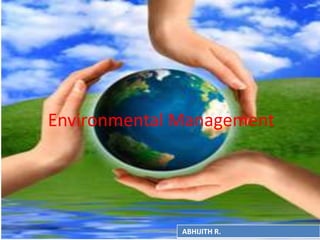
Environmental management
- 2. Environment Encompasses virtually everything that surrounds an organism in a holistic ecological approach Life on earth experiences different types of surroundings. Physical environment- soil, air, water…. Biological environment – living beings.
- 3. Fundamental principles for the protection of environment Maintenance of biodiversity Maintenance of all gaseous & material cycles & interdependence of living organisms among themselves & with abiotic environments. Maintenance of ecological order & natural balance, which depend on the food chain relationship, sustainable productivity & biotic interaction.
- 4. Segments of environment Natural environment :- Abiotic component- a) Climatic factors-solar radiation, temperature, wind, rainfall, water current.. b) Physical factors- light, air, pressure& geomagnetism
- 5. Cont… (c) clinical factors- oxygen, carbon dioxide , acidity, salinity, availability of inorganic nutrients & so on.. Biotic factors:- microbes, plants, animals & all living organisms & their organic by- products
- 6. Cont… Man-made environment Crop fields Urban areas Industrial space Vehicles Power plants Telecommunications …
- 7. Cont… Social environment Formed by network of social institutions- political, religious & economic Family Activities including socialization of children, transference of cultural heritage & morals from one generation to the next.
- 8. Environment of the earth Air / Atmosphere: Envelope of gases– nitrogen, oxygen, carbon dioxide, traces of carbon monoxide, oxides of nitrogen, sulphur, hydrocarbon & very little amount of water vapour.
- 9. Layers of atmosphere 1. Troposphere 2. Stratosphere 3. Mesosphere 4. Thermosphere (ionosphere) 5. Exosphere
- 10. Cont…. Water / Hydrosphere: Oceans, seas, rivers, lakes, ponds, polar ice caps, streams, glaciers, ground water, & water vapour. Oceans are storehouses of vast resources- water, salt, minerals, & food.
- 11. Cont… Land / Lithosphere Is the outer mantle of rocks constituting the earth’s crust. Rocks are subjected to continuous physical, chemical & biological weathering. Thickness ranging from 64 to 96 km.
- 12. Cont… Below the lithosphere lies the mantle; thickness of 2400km. Upper part is Asthenosphere Lower mantle is Mesosphere The interior part of earth is Core, consist of minerals such as iron, nickel, cobalt mixed with sulphur & silica
- 13. Cont… Inner core appears to be solid Outer core is molten and metallic The direction & interaction b/w the atmosphere, hydrosphere & lithosphere for millions of years has made the earth suitable for life & has formed the Biosphere. Which is responsible for large scale of recycling of matter & energy.
- 14. the study of the relationships between biotic and abiotic factors in environments eco (G) root home, abode ecoclimateecosyste m ecotourism log, -o, y (G) suffix study of zoologyepidemiologyclimatology EcologyEc o logy
- 15. a major regional or global biotic community, a super ecosystem, defined chiefly by the dominant forms of plant life and the prevailing climate Biome
- 16. desert grassland tropical rain forest deciduous forest coniferous forest tundra Major Biomes of the World ocean
- 17. Aquatic biomes 2 types – marine and freshwater. Stratified vertically – photic zone (light) and aphotic zone (little light). Bottom of aquatic is benthos – food is detritus that falls from above.
- 18. Lakes ALakes classified by nutrients – 1eutrophic – shallow and nutrient-rich; 2oligotrophic – deeper and nutrient-poor.
- 19. *Wetlands Wetlands – area covered with water; supports plants. Estuaries – area where freshwater meets ocean. Intertidal zone – land meets water. Coral reefs – dominated by coral.
- 20. Terrestrial biomes Defined vertically from the canopy at top to the permafrost at the bottom. ATropical forest – little light reaches ground because of deep canopy. Rainfall determines life in area.
- 21. Cont… BSavanna – scattered trees and grasses. Fire helps increase diversity. Has rainy season. CTemperate grassland – seasonal drought, fires prevent tree growth. Most used for farming.
- 22. Deserts Deserts – sparse rain, some are cold. Plants have structures to allow survival (i.e. water storage, alternative forms of photosynthesis) Chaparral – evergreen shrub; long, hot, dry summers with fires.
- 23. Forest Temperate deciduous forest – small mammals, leaves fall during autumn. Coniferous forest – cone-bearing trees, trees have needles. Tundra – permafrost covers ground, low diversity.
- 24. Levels of Organization smallest unit of living things group of similar cells organized to work together group of different kinds of tissues working together group of organs working together one individual living thing all organisms of the same kind living in one area all interacting populations in an ecosystem all living and nonliving things interacting within a certain area large region with typical plants and animals that includes several ecosystems cell
- 25. Changes to Agriculture: •1 After the Second World War, farming changed dramatically and became more intensive. •2 It changed because of the need for farmers to maximize production. •3 Farms became specialist such as growing cereals and little else. •4 This was made possible with the advent of cheap inorganic fertilisers, pesticides, •new high yielding varieties and improved mechanization. •5 Yields improved dramatically (Wheat yields in the 1950’s were about 2 tonnes per hectare and now in excess of 10 tonnes). 6 Food has also become much cheaper. Agriculture
- 26. Effects of intensive agriculture: Benefits : High yields Greater productivity Cheaper food Higher quality food
- 27. Cont… Problems: Pollution(excess nitrates & pesticides) Disease Waste disposal (straw from cereals, slurry from livestock) Toxic materials entering the human food chain Damage to the environment Loss of jobs
- 28. Agriculture – Monoculture and Intensive Farming Intensive agriculture is characterised by most of the following: Large areas of monoculture (growing one species or crop). High level use of – Fertilisers (especially inorganic fertilisers) Pesticides (includes herbicides) Mechanisation (large tractors etc)
- 29. Cont…. Improved varieties of plants and animals Irrigation schemes (allows continuous cropping) Continuous cropping from one area year after year Several crops per season from the same land Low labour input Maximum yields for a minimum area of land Attempts to maximise profits
